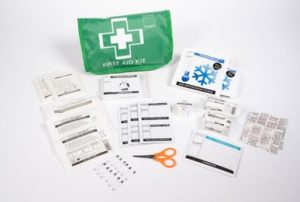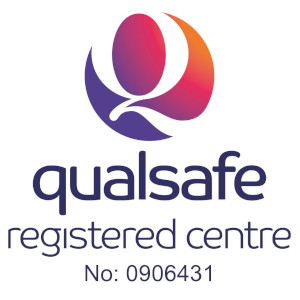Minor injuries like scrapes, burns, or sprains happen to everyone. Treating minor injuries at home and knowing the correct ways can prevent bigger problems and help you heal faster. This guide will teach you how to safely handle common accidents and injuries at home.

- Learn how to assemble a well-stocked first aid kit for your home
- Discover the essential medical tools and equipment to have on hand
- Understand the proper techniques for treating burns, cuts, sprains, and other minor injuries
- Recognise when a minor injury requires professional medical attention
- Familiarise yourself with common household accidents and their immediate care
Essential First Aid Supplies Every Home Should Have – Treating Minor Injuries at Home
Having a well-stocked first aid kit is key for any home. It helps you deal with minor injuries and emergencies. With the right tools, medications, and ointments, you’re ready for unexpected health needs.
Basic Medical Tools and Equipment
A good first aid kit has essential medical tools. You’ll need bandages, wet wipes, gauze pads, adhesive tape, scissors, tweezers, a thermometer, and a CPR mask. These items help you care for injuries quickly and stop them from getting worse.
Essential Medications and Ointments
Your home first aid kit could also have important medications and ointments. This includes antiseptic cream, antihistamine tablets, pain relievers, anti-diarrhoeal medication, and hydrocortisone cream. These can ease symptoms and help wounds heal for many minor health problems.
Storage and Organisation Tips
It’s important to store and organise your first aid kit well. Keep it in a cool, dry place like a cabinet or cup
board. Make sure it’s labelled clearly and organised. Check expiration dates and replace items that have expired or been used up.
By having a complete first aid kit, you can feel confident that your home is ready for minor emergencies. It’s a vital part of home healthcare essentials.
How to Treat Minor Injuries at Home
Dealing with minor accidents or injuries at home is crucial. Knowing how to treat wounds and injuries can be very helpful. It’s important to learn a few key steps to handle these situations well.
Let’s look at some essential steps to treat minor injuries safely and effectively at home.
Proper Wound Cleaning and Dressing
Cleaning the wound is the first step in treating a minor injury. Use clean water remove dirt or debris. Pat the area dry with a clean towel.
Next, apply an antiseptic ointment or cream to prevent infection. Then, cover the wound with a sterile bandage or adhesive strip to protect it while it heals.
Pain Management Techniques
Addressing pain and discomfort is crucial when caring for minor injuries. Use over-the-counter pain medications like paracetamol or ibuprofen to help with pain. For sprains or strains, a cold compress can also help reduce swelling.
Monitoring for Signs of Infection
Keep an eye on any minor injuries for signs of infection. Look out for increased redness, swelling, or pus. If you see these signs, or if the pain gets worse, seek medical help.
By learning these basic wound care and injury treatment techniques, you can handle minor accidents confidently. Remember, always seek professional medical advice if unsure or if the injury is severe.
Common Household Accidents and Their Immediate Care
Accidents can happen in any home. It’s crucial to know how to care for common injuries right away. This includes burns, scalds, cuts, grazes, sprains, and strains. Quick and proper care can greatly aid in recovery.
Burns and Scalds Treatment
For burns and scalds, cool the area with cool water for 10 minutes first. This stops the burning and prevents more damage. Then, dry the area gently and cover it with a sterile dressing. Don’t use butter or toothpaste, as they can make things worse.
Cuts and Grazes Management
Stop any bleeding from cuts and grazes by applying firm pressure with a clean cloth. Once it stops, clean the area with soap and water and cover it with a sterile dressing. If the cut is deep or keeps bleeding, get medical help.
Sprains and Strains First Aid
To treat sprains and strains, use the RICE method. Rest the area, apply ice to reduce swelling, use a compression bandage, and elevate the limb. If the pain and swelling don’t improve, see a doctor.
Knowing how to treat common accidents, burns, wounds, and sprains is key. Quick and correct first aid can prevent more serious issues. Always act fast and follow the right steps for the best results.
When to Seek Professional Medical Help
It’s important to know when to get help for minor injuries at home. While many can be treated with basic first aid, some need a doctor’s help.
Here are some signs you should get emergency medical care:
- Severe bleeding: If bleeding doesn’t stop after you apply pressure, you need a doctor.
- Broken or dislocated bones: If you see a bone out of place or can’t move it, see a doctor.
- Head injuries: If you hit your head and feel confused or have a headache, see a doctor.
- Severe burns: Burns that are big, blister, or on sensitive areas need a doctor right away.
If you’re not sure if you need a doctor, it’s safer to get checked. Quick medical care can prevent serious problems.
“When in doubt, get it checked out. Don’t risk your health by trying to tough it out.”
Always put your health first. If you’re worried about an injury, call for help or go to a doctor.
Conclusion
Being ready for treating minor injuries at home is key to keeping your family safe and healthy. Having the right first aid supplies and knowing how to treat common accidents helps a lot. This way, you can deal with problems fast and stop them from getting worse.
We’ve looked at the important medical tools, equipment, and medicines every home needs. We’ve also shown how to handle different minor injuries, like burns, cuts, sprains, and strains. Following this advice will help your family be ready for any unexpected situations and keep everyone healthy.
Finally, home first aid summary and injury prevention are vital for a safe and healthy home. Make sure to check out the info we’ve shared, get the right supplies, and be quick to act on any minor injuries. With the right knowledge and preparation, you can take care of your family’s health and safety confidently.
FAQ – Treating Minor Injuries at Home
What should I do if I cut myself?
First, clean the cut with clean water. Then, apply antiseptic cream and cover it with a bandage. If it bleeds a lot or looks deep, see a doctor.
How can I treat a minor burn?
Cool the burn with water for a few minutes. Use aloe Vera gel or moisturiser, then cover it with a bandage. Don’t use ice or butter, and don’t break blisters.
What’s the best way to treat a sprain or strain?
Use the RICE method: Rest, Ice, Compress, Elevate. Also, take over-the-counter pain meds to ease swelling and pain.
When should I seek professional medical help for an injury?
Get medical help for deep cuts, broken bones, or big burns. Also, if pain, swelling, or bleeding gets worse, or if you’re worried, see a doctor.
How can I prepare my home for potential minor accidents?
Keep a first aid kit ready with bandages, wipes, and pain meds. Make sure it’s easy to find and check the contents’ dates. Learn basic first aid to act fast in emergencies.
What should I include in a home first aid kit?
Your kit should have bandages, gauze, wipes, tape, scissors, tweezers, and pain meds. Add antihistamines, cream, gel, thermometer, and any prescription meds. Include emergency numbers and first aid tips.
How can I prevent minor household accidents?
Keep your home tidy and well-lit. Be careful with sharp objects and watch children. Check for hazards like loose rugs and fix them quickly.
If you have any questions with this blog we are happy to help. It is important to know what to do in case of an emergency or a minor injury. If you want to know how, our Emergency First Aid at Work Course, is the course for you. Here is the link to our upcoming courses. https://www.hmbtrainingservices.co.uk/courses
Our courses provide you the peace of mind that you’ll know what to do in the event of an emergency, such as choking. Furthermore, getting first aid training will give you the skill set of knowing exactly what to do if your child, friend, or work colleague chokes. Never put yourself in a situation where you’re thinking, “What if I knew what to do?” Get First Aid Trained Today!
We offer open courses at our Brownhills training room or we can come to your training room at your workplace. We travel to the top side of London and as far as Liverpool or Manchester.
For further enquires please call us on: 01543 453338 or email on info@hmbtrainingservices.co.uk



